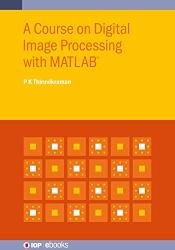A Course on Digital Image Processing with MATLAB
- Добавил: literator
- Дата: 25-01-2022, 14:52
- Комментариев: 0
 Название: A Course on Digital Image Processing with MATLAB
Название: A Course on Digital Image Processing with MATLABАвтор: P.K. Thiruvikraman
Издательство: IOP Publishing
Год: 2020
Страниц: 273
Язык: английский
Формат: pdf (true), epub
Размер: 28.8 MB
Describes the principles and techniques of image processing using MATLAB. Every chapter is accompanied by a collection of exercises and programming assignments. The book is augmented with supplementary MATLAB codeand hints and solutions to problems are also provided.
Digital image processing has applications in almost all fields of science and engineering as practitioners in these fields have to, at some point, handle images. The applications of digital image processing can be seen and felt in fields as diverse as remote sensing, astronomy, material science, and medical diagnosis. Even ordinary citizens now encounter on a routine basis automatic fingerprint recognition, iris recognition, and biometric systems. Surveillance systems are being automated to a great extent and driverless cars and pilotless planes may soon be a reality.
While the applications of image processing are very obvious, where does somebody who wants to learn the basics of this subject start? What are the recurring threads that connect the myriad applications of this field? This book is an attempt to answer such questions.
The Fourier transform is a widely used tool in image processing. It has been applied to a wide variety of tasks ranging from filtering to image compression. While the Fourier transform is an elegant and powerful tool, an even more powerful mathematical tool, known as the wavelet transform, has emerged in recent years. Wavelets are localized functions. Therefore, the positional information about the occurrence of various frequencies is built into them in a natural way. While the Fourier transform uses only two functions—sine and cosine functions—wavelets come in many varieties. We will confine our discussion about wavelets to the Haar wavelet, which is the simplest of the wavelets.
MATLAB is one of the most widely used software packages for the analysis and visualization of data in science and engineering. It is also well suited for implementing algorithms for image processing since it has a separate image processing toolbox. The image processing toolbox contains many built-in functions for implementing many of the algorithms we have discussed in this book. MATLAB has a number of toolboxes that facilitate its application in many fields. One of the toolboxes available with MATLAB® is the Image Processing Toolbox. The Image Processing Toolbox consists of a large number of built-in functions that make it very easy for us to implement various algorithms used in image processing.
However, while using the toolboxes, one should not get carried away and overuse the built-in functions. Relying too much on built-in functions will not help us to understand the details of the various algorithms we use. Understanding the details of each algorithm is essential if we have to modify and make them more efficient. Writing our own programs (instead of using built-in functions) will also help us in situations where we cannot use MATLAB. Since MATLAB is a high-level language whose commands have to be translated into lower-level languages by the computer, MATLAB programs will not run as fast as programs written in languages like C. Therefore, it is not preferred for real-time applications. Furthermore, MATLAB occupies a lot of memory space. With these disadvantages you might well ask whether we are better off using a language like C. While it is true that MATLAB® has certain disadvantages, it has a number of advantages that has resulted in its widespread use in the field of image processing.
Developing programs in MATLAB is much simpler than in languages like C. Even as simple a task as reading an image file and storing the pixel intensities in an image requires a very large program with hundreds of lines of code in C. If we eschew MATLAB altogether, then we run the risk of making very slow progress and getting mired in the technicalities and syntax of programming languages.
Скачать A Course on Digital Image Processing with MATLAB
Внимание
Уважаемый посетитель, Вы зашли на сайт как незарегистрированный пользователь.
Мы рекомендуем Вам зарегистрироваться либо войти на сайт под своим именем.
Уважаемый посетитель, Вы зашли на сайт как незарегистрированный пользователь.
Мы рекомендуем Вам зарегистрироваться либо войти на сайт под своим именем.
Информация
Посетители, находящиеся в группе Гости, не могут оставлять комментарии к данной публикации.
Посетители, находящиеся в группе Гости, не могут оставлять комментарии к данной публикации.
